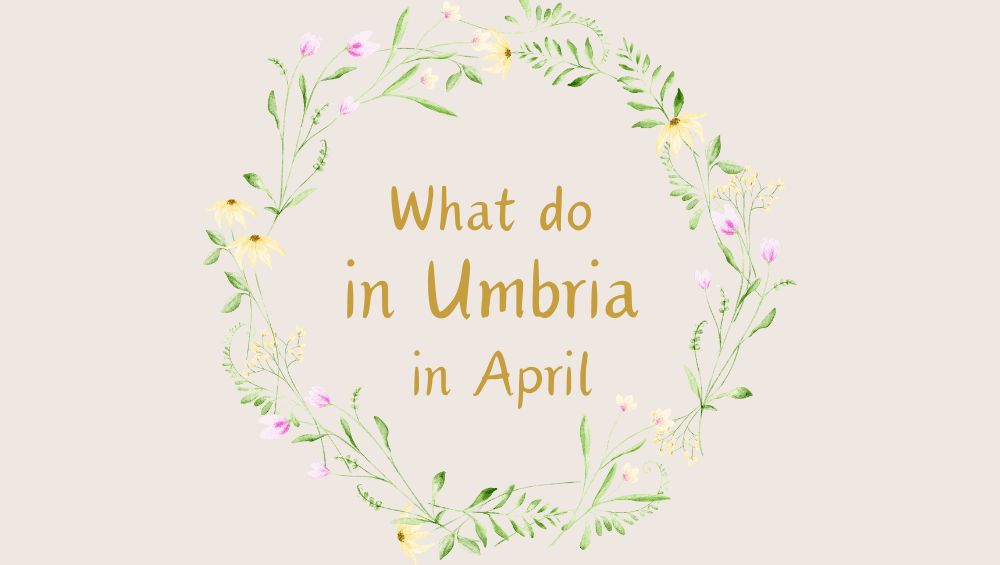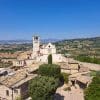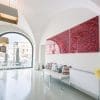What to do in Umbria in April? UmbriaSì tells you
Umbria in April dresses up in spring, offering a perfect mix of traditions, spirituality and lush nature.
With Easter coming, this month becomes a special time to discover the green heart of Italy.
Here are our three tips on what to do in Umbria in April

Experience the evocative Easter celebrations
Easter in Umbria is a unique spiritual and cultural experience. Attend religious celebrations in symbolic places such as the Basilica of San Francesco in Assisi or the Cathedral of San Lorenzo in Perugia. In villages such as Gubbio or Orvieto, Easter traditions come alive with historical re-enactments, processions and events that involve the entire community. The Good Friday Procession in Todi, for example, is an evocative and emotional moment.

Immerse yourself in blooming nature
In April, Umbrian nature is at its most splendor. Take a walk through the flowery meadows and olive groves, or explore the paths of Mount Subasio or the Trasimeno Lake Park, where breathtaking views combine with the perfect spring climate. Take advantage of the season for an outdoor picnic or to explore the flowery gardens of historic villas.

Taste the authentic flavors of Easter
Umbrian cuisine celebrates Easter traditions with unique dishes. Don’t miss the Torta di Pasqua, a delicious savory bread to be enjoyed with capocollo and local cheeses, or the classic roast lamb. Visit local markets to discover fresh products and typical sweets such as Ciaramicola, a shortcrust pastry cake covered in meringue and colored sprinkles. Complete your trip with a glass of Grechetto or Sagrantino wine, perfect for enhancing the Umbrian flavors.
 We are waiting for you in Umbria
We are waiting for you in Umbria 
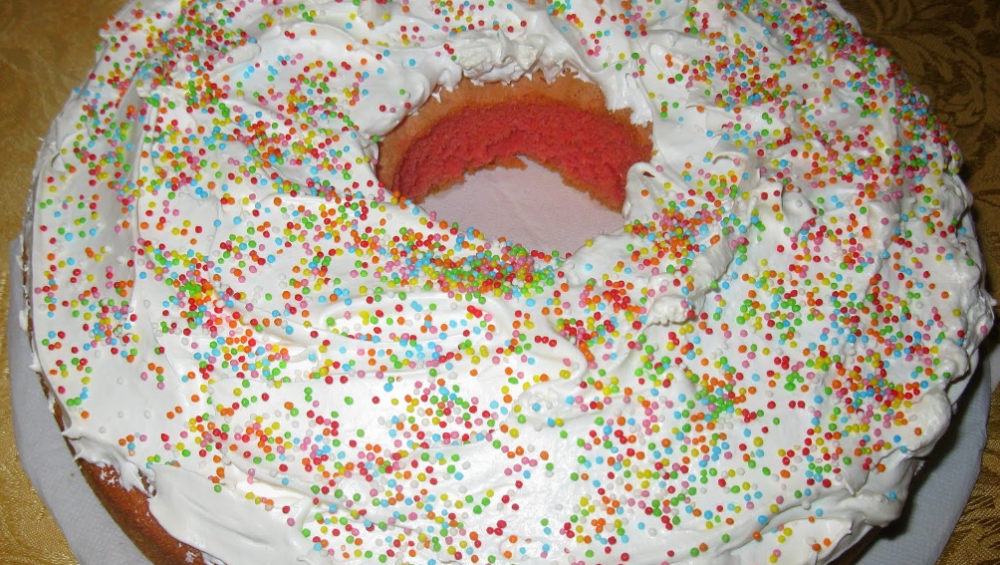
Easter recipes in Umbria
Ci si avvicina alla Pasqua e sulle tavole umbre, imbandite di leccornie e decorate dai profumi della primavera con i suoi colori e il dolce suono delle tortore canterine, non possono mancare due piatti tradizionali della cultura e enogastronomica umbra: il dolce Ciaramicola da gustare per la colazione oppure a fine pasto abbinato con un Vin Santo umbro da Grechetto e Trebbiano, e la Torta al formaggio che accompagna salumi e antipasti ricchi e saporiti.
La Ciaramicola e le sue origini
Una ciambella conosciuta nei borghi perugini già nel XV secolo, è un dolce lievitato ricoperto di candida meringa e arricchita a adornata da colorati confettini. Il suo impasto interno di presenta di un coloro rosso/rosato conferito dal liquore che si utilizza per questo dolce: l’Alchermes, a base di cocciniglia, acqua di rose, vaniglia, cannella, chiodi di garofano e coriandolo. Un liquore italiano molto amato dalla famiglia dei Medici.
Il nome Ciaramicola, etimologicamente, deriverebbe da diverse sfumature di significato:
- Da Ciaramella: per la circolarità della sua forma;
- Da Ciarapica: il nome dialettale della Cinciallegra, l’uccello della primavera;
- Da Ciara: in riferimento alla meringa fatta da albume d’uovo o dalle chiare dell’uovo.
La tradizione poi vuole che la Ciaramicola fosse un dolce che le fanciulle regalassero a Pasqua ai loro futuri mariti come buon auspicio.
Un’altra tradizione importante del territorio umbro è legata alla festa di Sant’Ubaldo, patrono di Gubbio. In un testo del 1431 si legge, infatti, che la Ciaramigola venne fatta preparare e offrire agli eugubini in occasione della festa del Santo il 15 maggio.
Infine, capita spesso di trovare la Ciaramicola con 5 “ciuffetti” di meringa, in rappresentanza de cinque Rioni Perugini: Porta Santa Susanna rappresentata dal colore azzurro dei confettini (per l’orientamento verso il Lago Trasimeno della Porta), Porta Eburnea dal colore verde (gli orti), Porta Sant’Angelo dal colore rosso (la spada dell’Angelo), Porta San Pietro dal colore giallo (come il grano), Porta Sole bianca come la meringa e come la luce del sole (il sole infatti è il simbolo di questa Porta).
La ricetta della Ciaramicola
Ingredienti per la ciambella:
- 550gr di farina 00
- 250 gr di zucchero
- 150gr di strutto (alternativa burro)
- 4 uova
- 1 bustina di lievito per dolci
- Scorzetta di 1 limone
- 200ml di Alchermes
Ingredienti per la meringa:
- 100 gr di albumi
- 200 gr di zucchero
- 1 cucchiaino di cremar tartaro
Per la decorazione:
- Confettini di zucchero colorati
Procedimento:
Cominciamo col montare uovo e zucchero fino a ottenere una spuma omogenea alla quale aggiungeremo la farina e il lievito setacciati, lo strutto a temperatura ambiente, la scorzetta di limone grattugiata ed infime l’Alchermes. Dopo aver amalgamato tutti gi ingredienti, la versiamo in una teglia imburrata. In forno per 45 minuti circa a 160°C.
Per la meringa montiamo a neve ad alta velocità gli albumi con il cremar tartaro e gradualmente lo zucchero. Dovrà risultare ferma, soffice e lucida.
Una volta che la ciambella sarà fredda, la ricopriamo di meringa e infine con gli zuccherini colorati. Di nuovo in forno per 25 minuti per far cuocere la meringa a 90°C.
La Torta al formaggio
Un lievitato ricco di formaggio e sapori tipico delle festività Pasquali in Umbria ma che si mangia e consuma tutto l’anno proprio per la sua bontà, la semplicità e la facilità di abbinamento con i salumi, soprattutto il capocollo e la norcineria.
Non di rado la Torta al Formaggio viene mangiata a colazione la mattina di Pasqua, ecco perché è conosciuta anche con il nome di Torta di Pasqua.
Nel De Agri Coltura, Catone scrive di una torta al formaggio famosa soprattutto a Tuoro sul Trasimeno.
La ricetta della Torta di Pasqua
Ingredienti:
- 500gr di farina 00
- 100gr di parmigiano grattugiato
- 75gr di pecorino grattugiato
- 10gr di lievito di birra
- 100 ml di olio evo
- 150m di latte
- 100gr di formaggio emmentaler
- 4 uova
- 10gr di sale
- Pepe qb
Procedimento
Iniziamo con il sciogliere il lievito del latte intiepidito. In una terrina, mescolare farina, pecorino e parmigiano, uova, il latte con il lievito ed infine l’olio a filo e cominciare ad impastare bene fino a fare amalgamare bene tutti gli ingredienti e a ottenere un panetto omogeno e liscio. Aggiungere il sale, il pepe e l’emmentaler a tocchetti molto piccoli o grattugiato. Porre l’impasto in uno stampo imburrato e lasciarlo lievitare per 2 ore poi infornarlo a 180°C per circa un’ora.
Copyright foto Torta al Formaggio by Spicchio d’Aglio
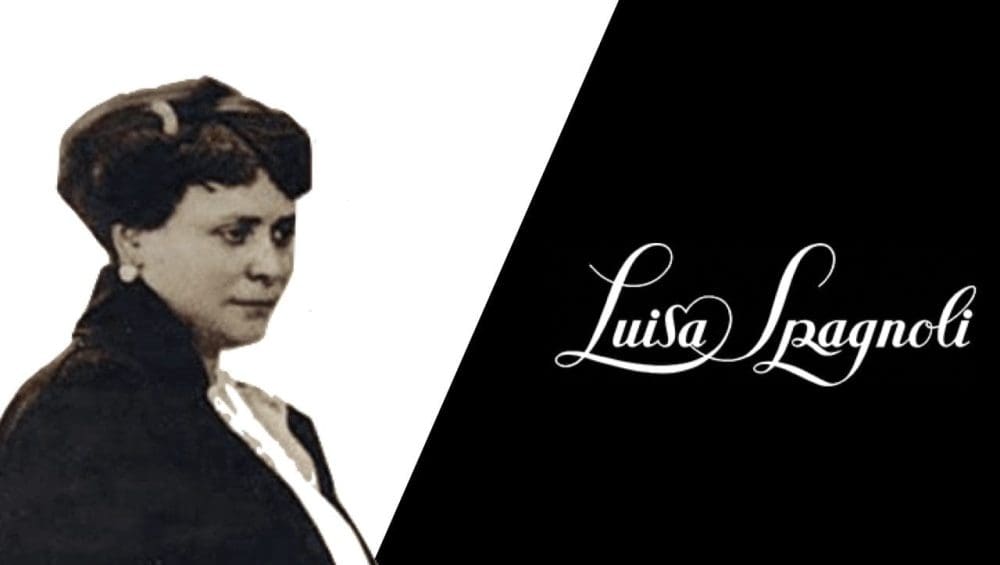
The Women of Umbria
On the occasion of March 8th, International Women’s Day, we want to celebrate it with some of the female figures who symbolize Umbria, a land rich in history, art, culture, and spirituality. Luisa Spagnoli, Marchioness Elena Guglielmi, Maria Vittoria Semolesti, Saint Clare of Assisi, and Saint Rita of Cascia… Women symbols of entrepreneurial spirit, faith and devotion, and still universal values of strength, courage, and independence, which continue to inspire women and men all over the world.
Luisa Spagnoli
A name that immediately evokes images of refined fashion and chocolaty delights. However, her legacy goes far beyond catwalks and delicacies. After the devastations of World War II, Luisa Spagnoli became passionate about Angora rabbits, not only starting to collect them but also discovering a secret that would revolutionize the world of fashion: the art of combing, rather than shearing, these animals. A gentle gesture that allowed for a yarn of unprecedented softness, a fabric that caressed the skin like no other. And what about her delicious chocolates? The Bacio Perugina is a name known all over the world, but there’s another bar that bears her name, a creation some Perugians affectionately call “Carrarmato” (“Tank”), perhaps as a tribute to her tenacity and strength of spirit.
Saint Chiara of Assisi
Born in Assisi in 1194, Chiara Offreduccio degli Scifi, better known as Saint Clare, was a revolutionary figure of her time. A friend and follower of Saint Francis, Clare renounced her comfortable life to embrace a life of poverty and service. The founder of the Order of Poor Clares, she placed prayer and dedication to others at the center of her existence, becoming a model of inner strength and determination.
Saint Rita of Cascia
Saint Rita, born Margherita Lotti in Roccaporena, near Cascia, in 1381, is known all over the world as the saint of impossible cases. Her life was marked by great suffering and challenges, from her youth, when she was forced to marry against her will, to the death of her sons and her husband’s illness. Despite the adversities, Saint Rita found refuge in the Augustinian monastery of Cascia, where she lived until her death in 1457. Her tomb, located in the Sanctuary of Saint Rita of Cascia, attracts thousands of faithful and visitors every year, testifying to the power of hope and perseverance even in the most desperate situations.
Elena Guglielmi and Maria Vittoria Semolesti
At the beginning of the 20th century, Marchioness Elena Guglielmi brought the technique of Irish lace making to Isola Maggiore in Lake Trasimeno, inspired by the traditions born in Irish monasteries at the end of the 19th century, according to the ancient art of Venetian lace. Instead of being made with needle and bobbins, the peculiarity of this lace is created with a crochet hook using an extremely thin yarn. In 1963, the islander Maria Vittoria Semolesti restarted the activity by founding a cooperative of lace makers for the sale of Irish lace.
Photo credits by:
Cittàdelladomenica.it
NestlèItalia.it
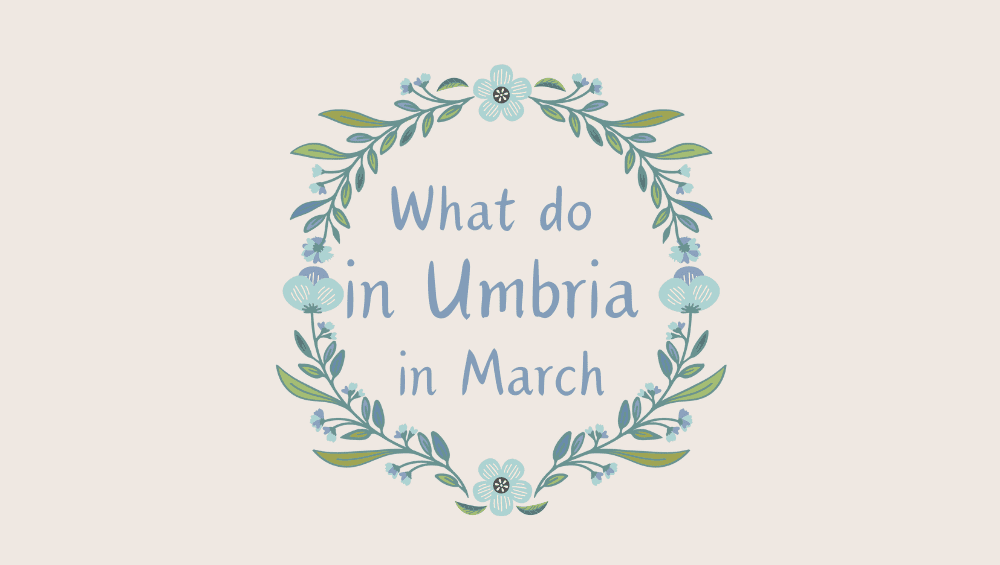
What to do in Umbria in March? UmbriaSì tells you
With the arrival of spring, Umbria awakens in a riot of colors and scents. March is the perfect month to discover this enchanted land, where culture, nature and authentic flavors meet.
Here are our three tips on what to do in Umbria in March

The magic of nature reborn
In March, the green heart of Italy offers a unique spectacle: flowery meadows, verdant hills and trees in bloom create postcard-like landscapes. It is the ideal time for walks in natural parks, such as Mount Subasio or the Trasimeno Lake Park, where the tranquility of nature completely envelops you. If you love photography or simply want to breathe pure air, you will find your corner of paradise here.

Authentic and less crowded villages
Spring is perfect for exploring the charming Umbrian villages calmly and without the summer crowds. Discover the flower-filled alleys of Spello, stroll among the medieval walls of Montefalco or lose yourself in the narrow streets of Gubbio and Todi. In addition to the architectural beauty, you will enjoy a warm welcome and an authentic atmosphere.

Seasonal Umbrian Flavors
March brings the fresh flavors of spring to the table. Enjoy first courses based on marzolino truffle, wild herbs and wild asparagus, which enrich traditional Umbrian recipes. Stop at a trattoria or agritourism to enjoy a genuine culinary experience, accompanied by a glass of Grechetto or Rosso di Montefalco wine.

 We are waiting for you in Umbria
We are waiting for you in Umbria 
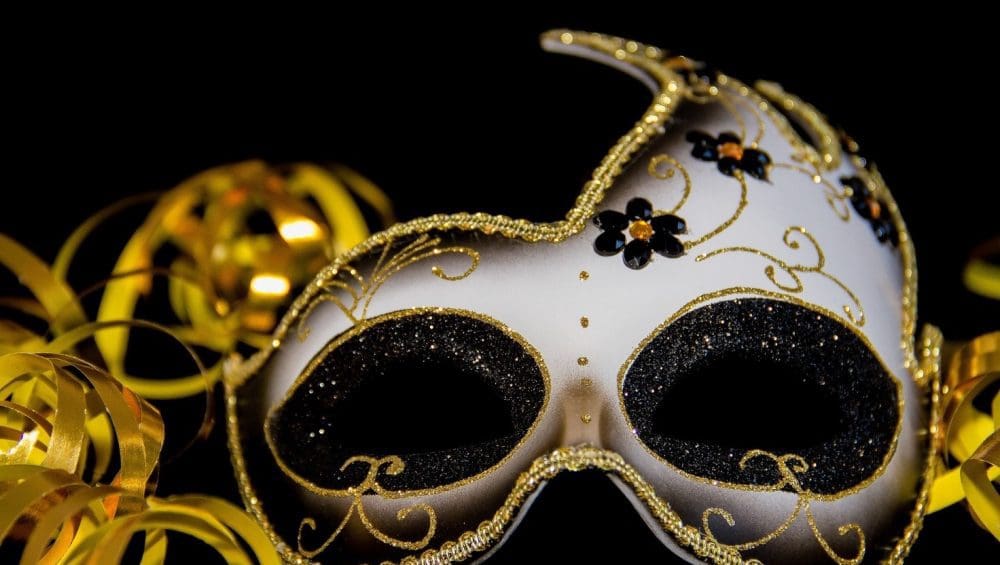
Carnival sweets in Umbria
The ancient Latin saying reads
“semel in anno licet insanire – once a year it is permissible to go crazy”
Carnival Origin
The common thread that binds Carnival, the mask or masquerade party par excellence, all over the world seems to be precisely the concept that is furthest from what the Romans called mos maiorum, good morals, morality.
But before we get to the Romans, let’s take a few steps back.
The origin of the Carnival dates back to 4000 years ago with the Egyptians and the rites in honor of Isis, the goddess of fertility.
With the Romans, the Carnival Festival coincided with the Lupercali, in honor of the God Luperco, symbol of Roman fertility. The period, for both Egyptians and Romans, is celebrated at the end of February.
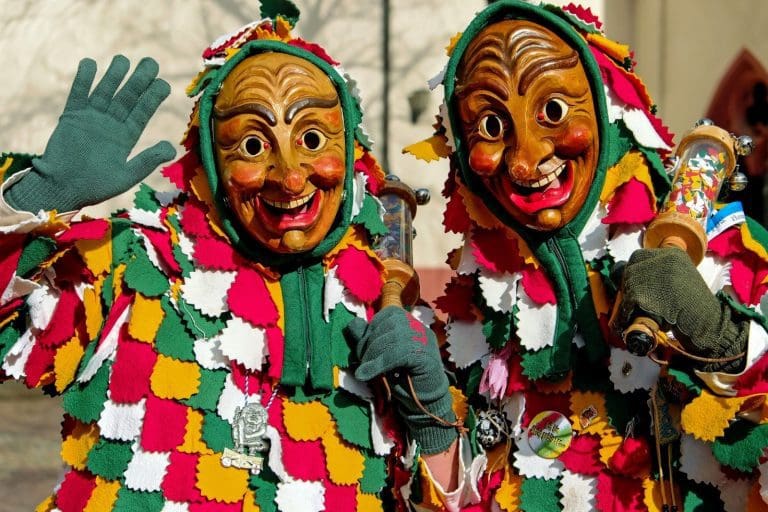
Sacred and Profane
The Carnival, between banquets, parties and masks, thus becomes a sort of social “level”: a disguise that hides the status of belonging and allows everyone to set aside moral rigidity for a day.
With Christianity, Carnival from the Latin “carnem levare”, Shrove Tuesday becomes the last day to eat meat before abstaining from consuming it during the period of Lent but also the last opportunity to fill your belly with sweets rich in sugars!
Tipical sweety food in Umbria
Whether it’s Egyptian, Roman or Christian, the “reasons” of Carnival are disguise (masquerade) and the consumption of food, especially sweets!
Let’s see what are the typical ones in Umbria:
- Frappe
Strips of sweet puff pastry in the shape of a bow. Covered with alchermes sugar or honey, they can be either fried (as per the original recipe) or baked in the “lighter” variant. In any case, the result is a crunchy, sweet and tasty pastry.
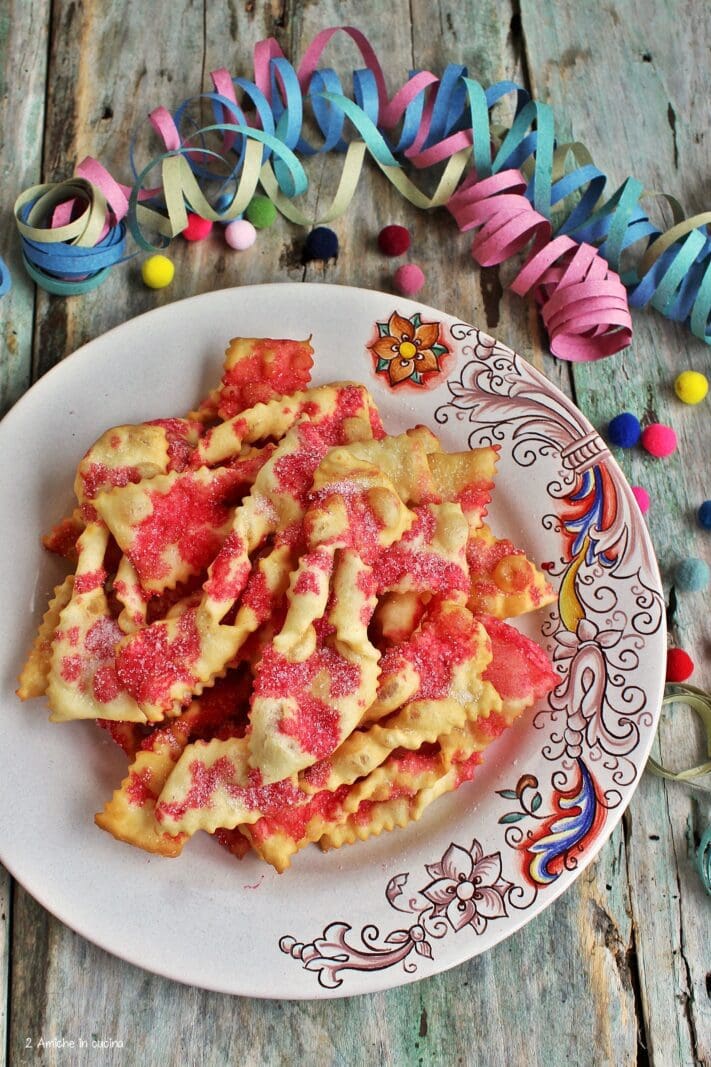
- Castagnòle
The name derives from the memory of the small chestnuts with their rounded shape. The dough is composed of flour, eggs, sugar, yeast and an aromatic liqueur. Also these sweets, as per tradition, are fried paying particular attention to making them golden on the outside and cooked well inside, helping them to remain round during cooking by moving the pan in a rotating direction. Then covered with sugar, honey or alchermes. - Strufoli
Traditional from Perugino, they resemble castagnole with the difference of having a softer texture and are, on the other hand, larger in size. They are then covered with sweet dripping honey.
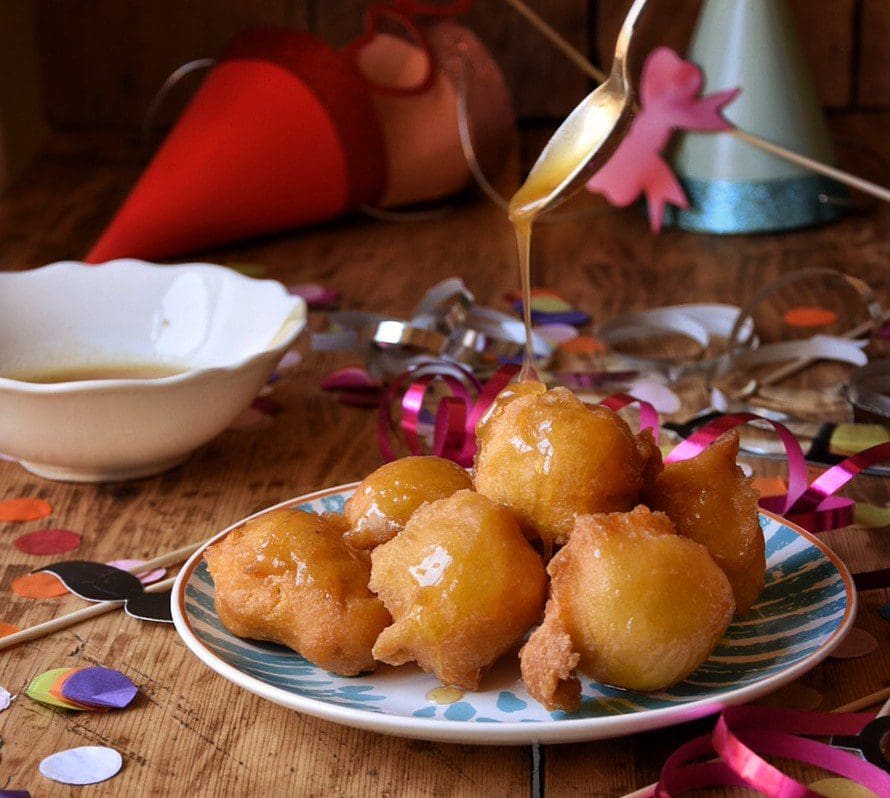
- Cicerchiata umbra
From the name of the Umbrian Cicerchia, a rounded legume, the cicerchiata is a crown of sweet balls covered in honey.

- Crescionda spoletina
With this dessert we move to Spoleto with its Crescionda.
Originally prepared with chicken broth, or lard, in fact also known as “grescia unta” for being particularly fat, sugar, cheese, chocolate and breadcrumbs were then added. Or the version prepared with apples and dried fruit. Today his recipe marries modernity using chocolate, milk and amaretti biscuits. It is also recognized as a Traditional Umbrian Agri-Food Product.
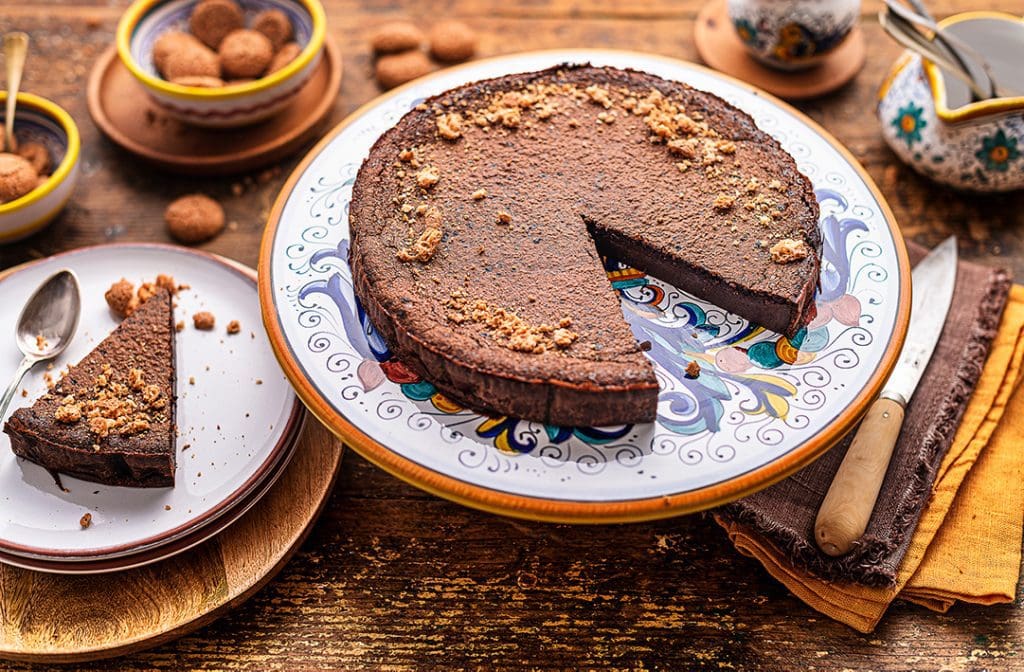
Credit photo
UmbriaTourism
Forchettiere.it
Antonio Gravante
2Amiche in Cucina

The Legends of Saint Valentine
The story of Saint Valentine of Terni is shrouded in mystery and folklore, with various legends intertwining over the centuries.
Saint Valentine is revered as the patron saint of lovers, and his feast day on February 14th is celebrated worldwide. Valentine was a Christian bishop from Terni, who died as a martyr in Rome on February 14th, 273 AD. He was laid to rest in Terni, in the Basilica where his relics can still be found today.
One of the most famous legends tells that Emperor Claudius II in the 3rd century AD had issued a decree that prohibited the marriage of young men, believing that singles made better soldiers. However, Valentine disobeyed this decree and continued to perform secret weddings for young couples. When his disobedience was discovered, Valentine was arrested and brought before the Emperor. During his imprisonment, legend has it that Valentine healed the blindness of his jailer’s daughter and that, before his execution, he wrote her a farewell letter, signing it “From your Valentine.”
This story has helped to cement Saint Valentine’s association with romantic love. Another version of the Saint Valentine story suggests that he might have been martyred for aiding persecuted Christians during the reign of Claudius II. Yet another legend tells of Valentine witnessing two young lovers arguing and giving them a rose, urging them to hold it together as a way to reconcile, and then having doves fly around them, hence the term “lovebirds.” In any case, the figure of Saint Valentine quickly became a symbol of love and devotion, and his feast day became associated with romantic love over the centuries.

Terni the City of Love and Steel
Do you only have one day to visit Terni? We’ll give you more than one reason to come back!
Morning: Art, history and flavors
Start your day with a stroll through the historic center of Terni. Explore Corso Tacito, among shops and cafes, and stop at the Cathedral of Santa Maria Assunta, an architectural jewel that combines history and beauty.
Continue to the Basilica of San Valentino, the patron saint of lovers. It’s a perfect place to discover a romantic and spiritual side of the city. Touch the tomb of the saint to bring home some luck in love.
Stop at a typical trattoria and let yourself be won over by the flavors of Terni. Try the ciriole alla ternana, similar to strangozzi, they are seasoned with a simple sauce of garlic, oil, tomato and chili pepper., a game dish or a soup of lentils from Castelluccio.
Never end the meal without tasting the dessert symbol of Terni, the Pampepato! A mix of dried fruit (walnuts, almonds, hazelnuts), honey, chocolate, cinnamon and pepper, baked in the oven.
Afternoon: Nature and Wonder
After lunch, head to the incredible Marmore Falls, one of the most exciting natural spectacles in Italy. Walk along the paths that lead to unique panoramic points and enjoy the spectacle of the waters plunging from 165 meters. Let yourself be enveloped by the magic of the sprays and, if you’re lucky, maybe even spot a rainbow. Check the opening times of the water so as not to miss the wow effect!
Evening: Relax and magical sunset
Conclude the day with a visit to Lago di Piediluco, a few kilometers from the waterfalls. This enchanted lake is perfect for relaxing and admiring a fairytale sunset. You can rent a boat or simply walk along the banks, immersed in tranquility. Treat yourself to dinner in a small restaurant on the shores of the lake. Try local fish dishes, such as royal perch, or a pizza accompanied by a good glass of wine. The reflection of the lake at dusk will be the icing on the cake of an unforgettable day. We are waiting for you in Umbria
We are waiting for you in Umbria
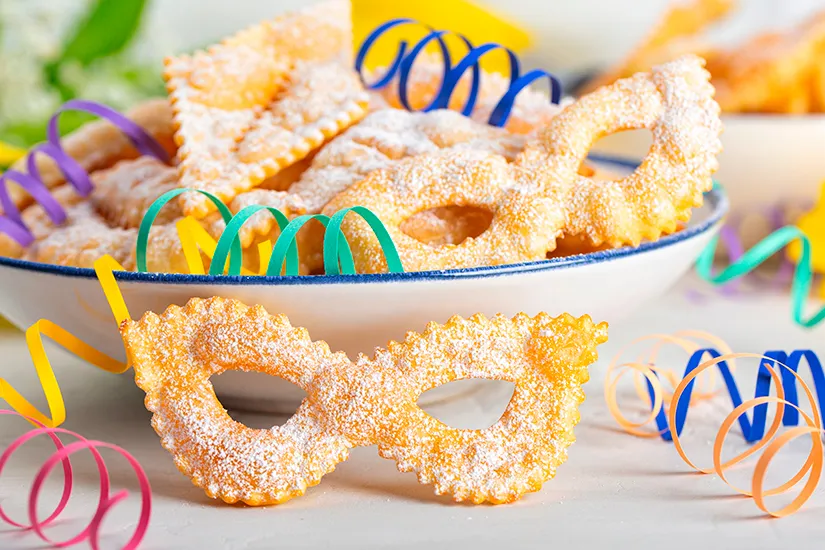
Carnival Recipes in Umbria
#COOK WITH UMBRIASI
We told you about Carnival, its origins and traditional Umbrian desserts.
Today here we bring you the recipes of the Carnival:
Prepare the apron, the work surface and ready to knead and then enjoy!
FRAPPE

Ingredients
500 g of 00 flour
3 eggs
Lemon peel to taste
1 teaspoon baking powder
250 g of butter
100 g of sugar
1 pinch of salt
For frying
1 liter of peanut oil
To decorate
Powdered sugar/honey or alkermes
Method
Create a fountain of flour on the work surface and arrange the baking powder in the centre, start mixing flour and baking powder, then always in the center add the eggs, the lemon peel (pay attention to the white part of the lemon which is more bitter) and the pinch of salt. Once the ingredients are mixed, add the butter at room temperature and the sugar. The dough will be ready when it is smooth, homogeneous and will come off easily from your hands. Let the dough rest for 30 minutes covered with cling film.
After 30 minutes, roll out the dough with a rolling pin until it forms a sheet that is not too thin. With the washer, cut the dough into rectangular strips with a small cut in the center where you pass one end of the frappa through the middle, simulating a bow.
Fry the frappe in hot oil for about 5 minutes. Once ready and cooled, decorate them with icing sugar, honey or alchermes as you like
CASTAGNOLE
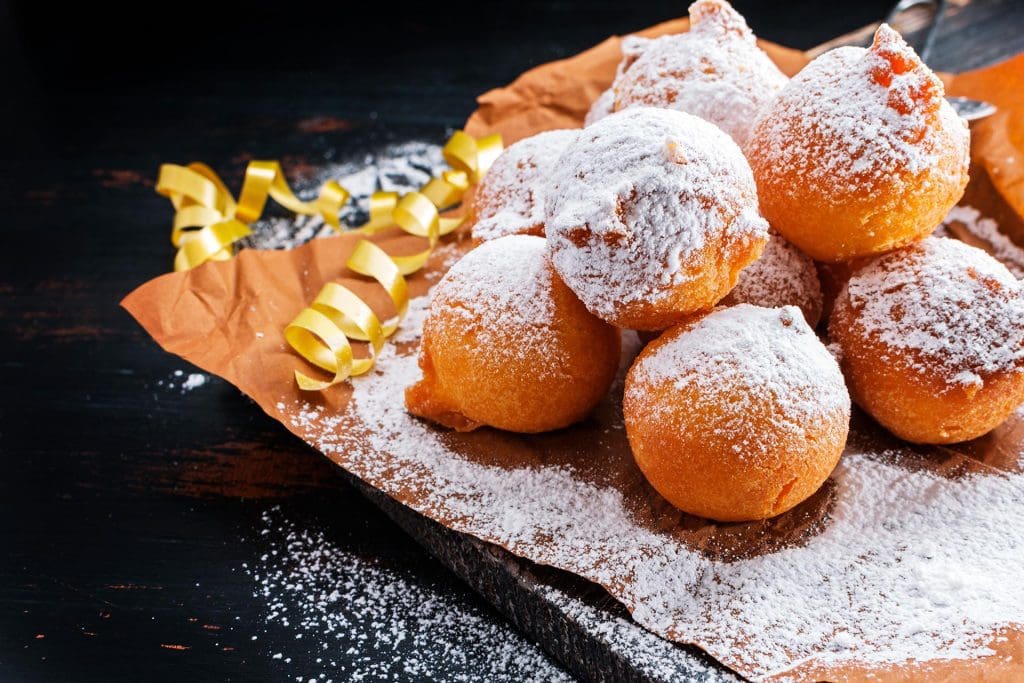
Ingredients
230 g of 00 flour
2 eggs
½ sachet of baking powder
4 Tablespoons of sugar
1 small glass of liqueur (mistrà, sambuca)
50 ml of milk at room temperature
2 tablespoons of extra virgin olive oil
Lemon peel to taste
1 pinch of salt
To frying
Plenty of peanut oil
To decorate
Icing sugar/honey or alchermes and colored sugared almonds
Method
Break the eggs into a small bowl and mix with the sugar until you have a frothy and light consistency. The sugar must be well mixed. Add the sambuca, slowly add the milk and oil and finally the grated lemon peel (pay attention to the white part, as above!). Mix everything until all the ingredients are well blended. Then add the flour and baking powder until you get a batter-like consistency.Let the mixture rest covered for about 10-15 minutes.Pour the batter into hot oil (help yourself with a spoon to form balls) and turn them halfway through cooking. Once ready, decorate with alchermes honey sugar and colored sprinkles
N.B There are variations that also include filling them with cream, chocolate cream or cream!
STRUFOLI

Ingredients
400 g of flour
6 eggs
6 tablespoons of sugar
1 small glass of Mistrà or Sambuca
1 lemon peel and lemon juice
1 cup of milk
25 g of baking powder
6 teaspoons of extra virgin olive oil
To frying
2 liters of peanut oil
To decorate
Honey
Method
With a whisk, beat the egg yolks with the sugar until you obtain a frothy consistency. Whip the remaining egg whites until stiff and add them to the yolks and mix well. Add the lemon peels and slowly add the oil and milk.
Gradually add the flour, baking powder, lemon juice and liqueur. Knead until you get a smooth and homogeneous dough. Sprinkle it with oil and cover it with a cloth to let it rest for at least 2 hours.
Slide the balls of dough into the hot oil (again with the help of a spoon). To help the dough remain round, slowly rotate the pan (with the handles) in which you are frying the strufoli (be careful! )
Once cooled, sprinkle them with honey melted in a bain-marie.
CICERCHIATA UMBRA

Ingredients
300 g of 00 flour
30 g of butter
3 eggs
1/2 grated lemon peel
Alchermes to taste
To frying
2 liters of peanut oil
To decorate
400 g of honey
colorful candies
dried fruit like almonds cut into strips
100 g of candied fruit
Method
On a pastry board, mix the flour with the eggs, the lemon peel, the butter at room temperature and the liqueur until a homogeneous and smooth consistency is obtained. Create sausages from the dough from which to obtain the irregular balls cut with a knife and fry them in hot oil. Heat the butter and once melted, pour the fried balls and mix well. Then add the sugared almonds, candied fruit and almonds to taste.
Then cut into strips 150 gr. of peeled almond
CRESCIONDA SPOLETINA

Ingredients
50 g of 00 flour
70 g of sugar
4 eggs
500ml of milk
200 g of macaroons
50 ml of mistrà liqueur
100 g of dark chocolate
1 grated lemon peel
Method
With a whisk or mixer, blend the amaretti biscuits. Then proceed by beating the yolks with the sugar until you get a frothy consistency; then add the minced chocolate, the liqueur and the milk slowly. Finally, the amaretti biscuits and the flour little by little, together with the grated lemon. Whip the egg whites until stiff which will then be joined to the mixture from bottom to top. Grease and flour a baking tray (24 cm in diameter) and bake at 180° for 60 minutes.
Credit photo
UmbriaTourism
Forchettiere.it
Antonio Gravante
2Amiche in Cucina
Fonte Cesia
Kasanova
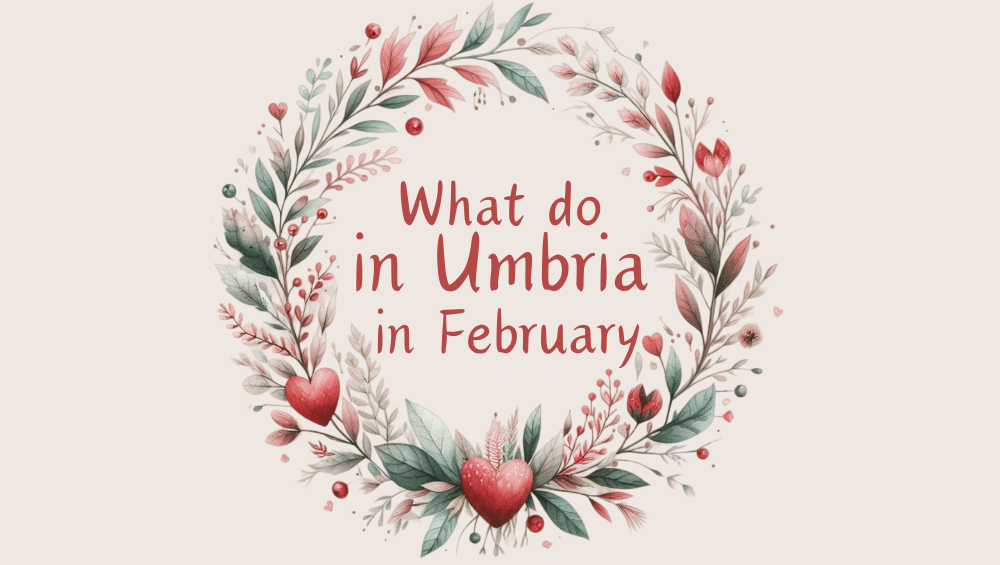
What to do in Umbria in February? UmbriaSì tells you
February is the month of Valentine’s Day, and Umbria, with its romantic charm and dreamy landscapes, is the ideal destination to celebrate love. Whether you want to surprise your better half or simply live an unforgettable experience, this land knows how to ignite romance.
Here are our three tips on what to do in Umbria in February
Celebrate love in the land of Saint Valentine
Terni, the birthplace of Saint Valentine, transforms into the beating heart of romance during this month. The Basilica of Saint Valentine hosts the evocative Festa della Promessa, where couples can renew their vows of love. In addition, the atmosphere is enhanced by special events, concerts and markets dedicated to lovers. A perfect opportunity to make your Valentine’s Day truly unique, immersed in a historical and romantic setting.Experiences to share: spa and relaxation for couples
February is the ideal month to indulge in moments of pure relaxation together. Choose a stay in one of the spas immersed in the Umbrian hills, where you can enjoy wellness treatments, couple massages and heated pools with breathtaking views. The intimate atmospheres and suggestive views create the perfect context to pamper yourself and share moments of complicity with your other half.A toast to love: tastings in the cellar
Umbria is a land of great wines and in February the cellars transform into ideal places to celebrate love. Many cellars offer exclusive packages for couples, with romantic toasts among ancient barrels and dreamy views. An experience that combines authentic flavors and unforgettable atmospheres. We are waiting for you in Umbria
We are waiting for you in Umbria 
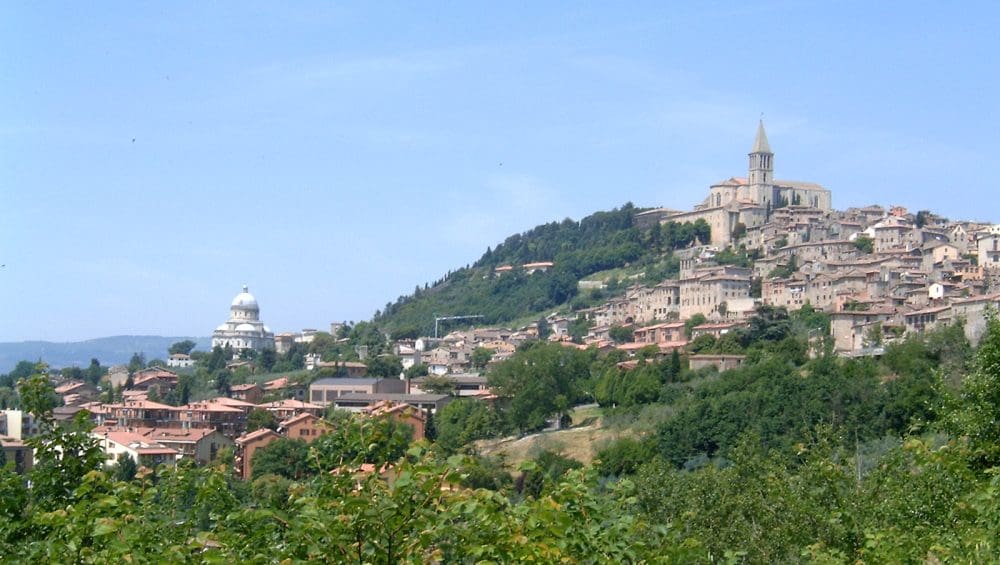
The Sanctuary of Merciful Love of Collevalenza
Umbria, with its picturesque hilly landscapes, medieval villages, and deep spiritual roots, is one of Italy’s gems. Among the numerous attractions this region has to offer, the Sanctuary of Collevalenza stands out as a place of devotion, hope, and reflection.
Located just a few kilometers from Todi, the Sanctuary of Collevalenza was founded at the behest of Mother Hope and built by the Spanish architect Julio Lafuente in 1951, with the intent of creating a place that represented and expressed God’s Mercy for all the faithful who had committed a sin and were seeking forgiveness and spiritual comfort.
An Enchanting Architecture
Beyond its spiritual significance, the Sanctuary also captivates visitors from an architectural standpoint: it has a circular plan with two large sacred halls, the crypt, and the upper church, which converge into a single architectural entity.
The Sanctuary creates a serene, welcoming, and bright atmosphere, thanks to a huge concave glass window.
Pilgrims visiting this sacred place are greeted with genuine smiles and a kindness typical of Umbrian hospitality. They can always confess, in the name of the same Mercy that the Sanctuary represents.
The Message of Water and the Famous Pools
Since March 1, 1979, the Water of the Sanctuary, coming from a nearby well, has been flowing into the pools (separated for men and women) and open to pilgrims or for the immersion of the sick, who could immerse themselves during the “Liturgy of the Waters” by the priests of the Sanctuary.
Currently, the “Liturgies of the Waters” are still active, while due to post-pandemic restrictions, immersions have been temporarily suspended, but at the same time, pilgrims who go to the Sanctuary and participate in the liturgy will be accompanied by the priest to the feet of the statue of Mary the Mediatrix to drink from the small fountains while reciting the prayer of the proper use of the Water and its spiritual meanings as “refreshment to the body and health to the soul and renewal of wonders for healings,” as always said by Mother Hope.
The Water of the Sanctuary is still considered a sign of Grace and an instrument of the Lord’s Mercy.
Commenti recenti
- A Taste of Umbria 5
- Accomodations 110
- Activity 8
- Attività 3
- Blog 41
- Christmas in Umbria 3
- Consigli 10
- Culture 10
- Events in Umbria 1
- Experiences 16
- La Contessa: a door between land and sea 36
- Mystic Umbria 5
- News 10
- Olive oil experiences 1
- Outdoor 3
- Packages 30
- Recipe 8
- Taste 3
- Tips 16
- Umbria A Journey through Time 10
- Umbria Beactive 12
- Umbria For Family 7
-
Hotel Monastero Sant’Andrea 28 November 2025
-
Hotel Boutique Castiglione del Lago 28 November 2025
-
Palazzo Bontadosi Hotel&Spa 28 November 2025
Via Settevalli, 320
06129 Perugia
Iscriviti per ricevere informazioni su pacchetti, offerte, eventi e manifestazioni in Umbria.
Privacy and Cookie Policy | Credits: GREEN CONSULTING
UMBRIAPERTA: BANDO PER IL SOSTEGNO ALL’ATTIVITÀ DI INCOMING” NUOVO PIANO DI SVILUPPO E COESIONE FSC”
Intervento relativo al Progetto “UmbriaSì per l’Incoming” è stato realizzato e finanziato con RISORSE FSC
La funzionalità del sito web è stato implementa con il sostegno delle risorse del Nuovo Piano di Sviluppo e Coesione FSC


